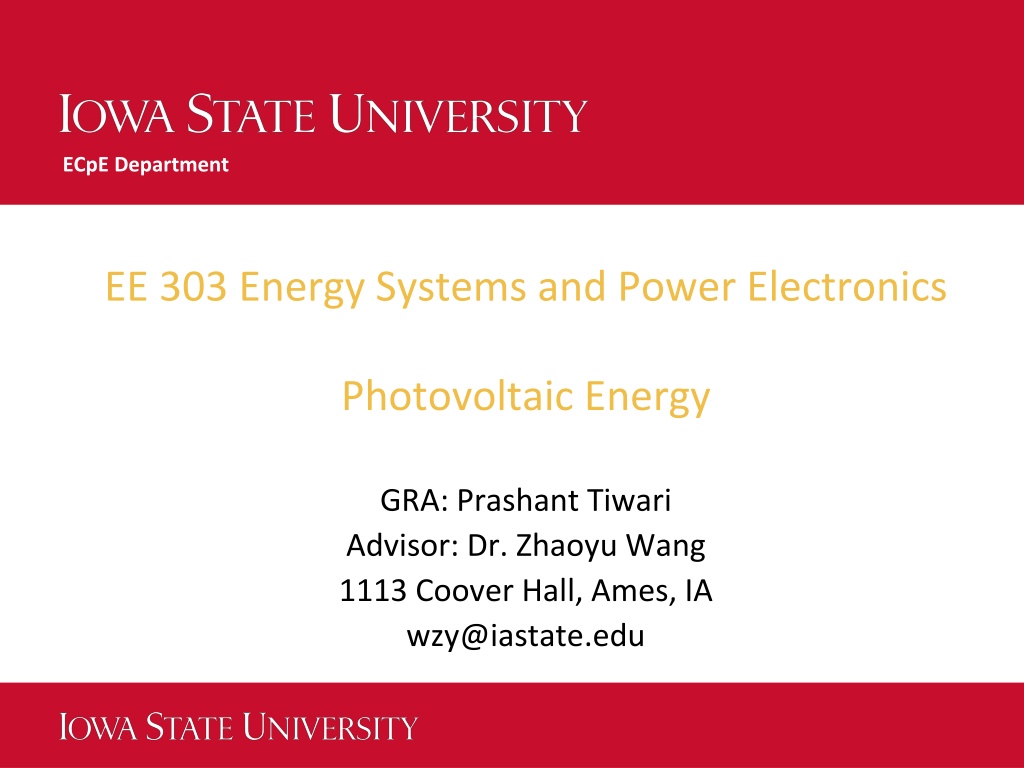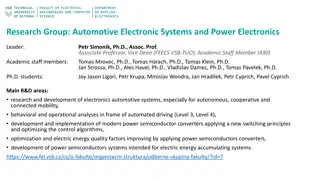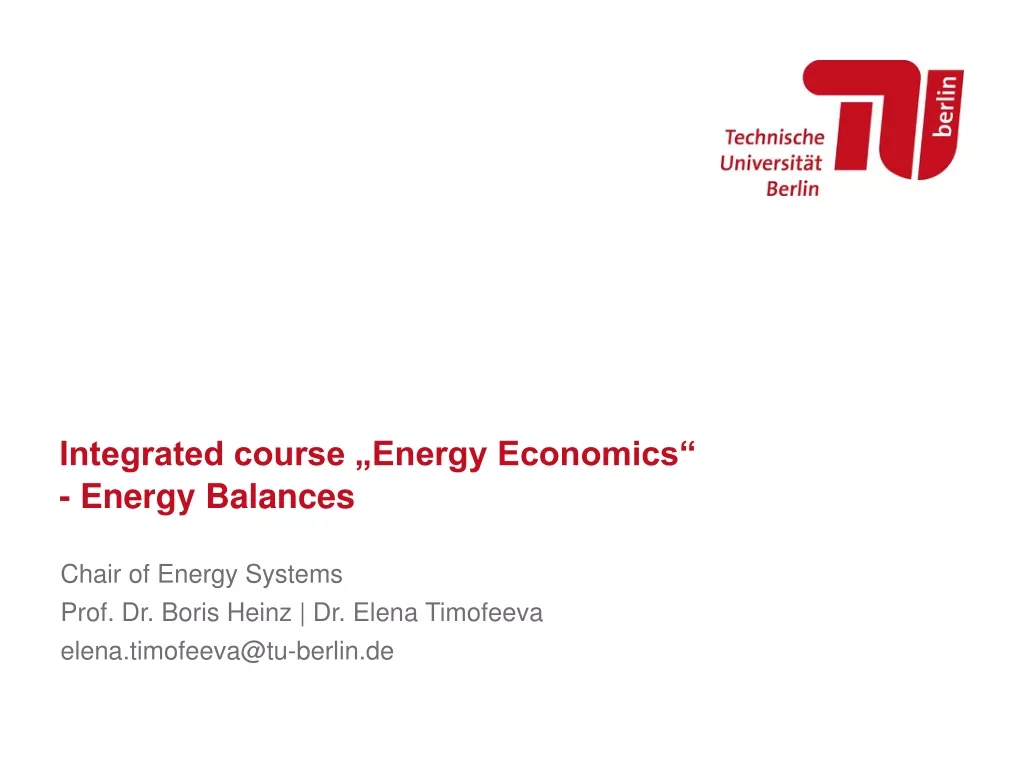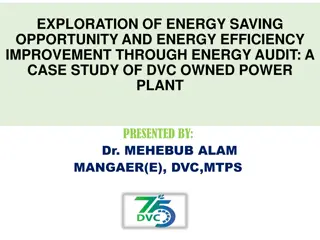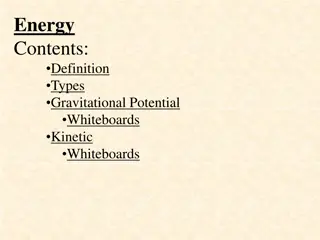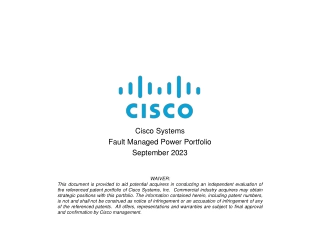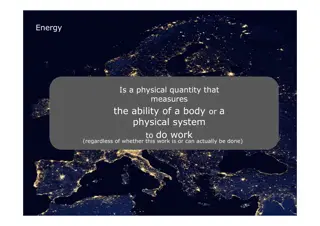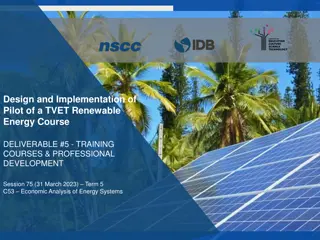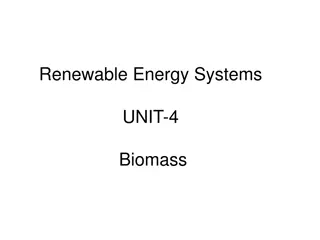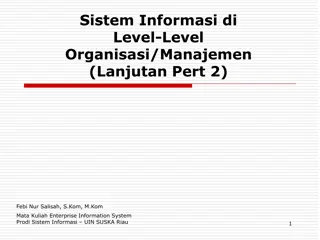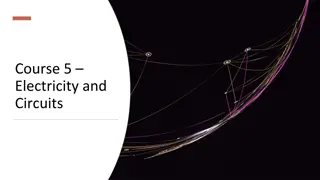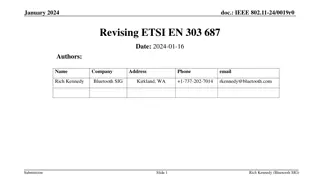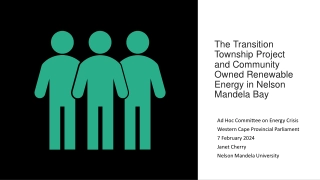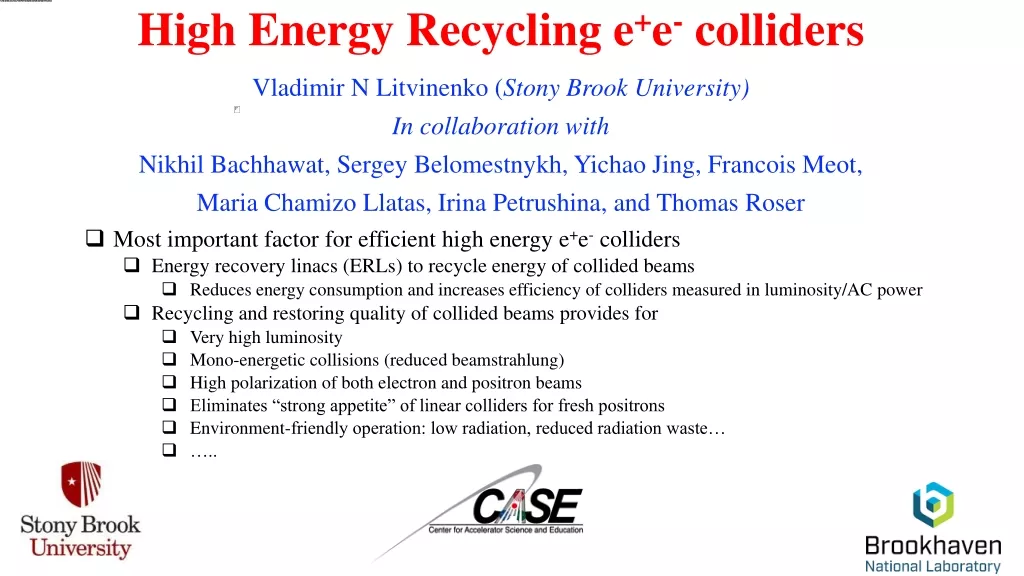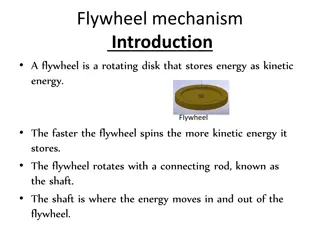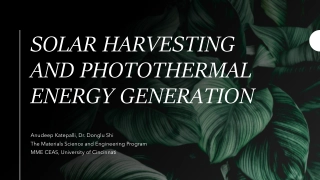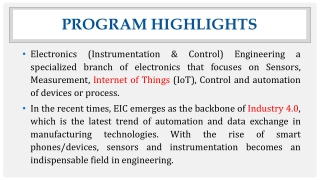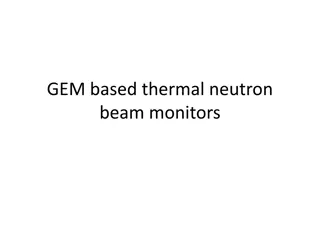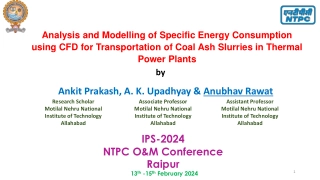EE 303 Energy Systems and Power Electronics
Photovoltaic (PV) energy systems offer numerous benefits such as utilizing solar energy, being modular and low maintenance, and having a long lifespan. The Energy Payback Time (EPBT) is crucial for assessing sustainability, and advancements in material usage, efficiency, and manufacturing processes will continue to enhance PV systems. Global trends in solar irradiation, pricing, and cumulative installations provide insights into the growing adoption of PV technology worldwide.
Uploaded on Mar 07, 2024 | 2 Views
Download Presentation

Please find below an Image/Link to download the presentation.
The content on the website is provided AS IS for your information and personal use only. It may not be sold, licensed, or shared on other websites without obtaining consent from the author. Download presentation by click this link. If you encounter any issues during the download, it is possible that the publisher has removed the file from their server.
E N D
Presentation Transcript
ECpE Department EE 303 Energy Systems and Power Electronics Photovoltaic Energy GRA: Prashant Tiwari Advisor: Dr. Zhaoyu Wang 1113 Coover Hall, Ames, IA wzy@iastate.edu
Benefits of PV The advantages of PV are manifold: unlimited resource of solar energy, available in all parts of the world, modular, it varies from milliwatt in consumers products up to gigawatt in future power stations, during operation, it produces electricity with no air emissions and no waste production, virtually no maintenance, silent during operation, proven technical lifetime of 30 + years. 2 ECpE Department
PV Energy Payback Time The energy payback time (EPBT) of PV systems is an important criterion in understanding their sustainability. The EPBT is the amount of time a PV system has to operate in order to compensate for the energy required to fabricate the system itself. 3 3 ECpE Department ECpE Department
Contd The EPBT of PV systems will continue to decrease in the future due to: reduction in material usage (e.g. thinner silicon wafers, thin-film modules), higher system efficiencies for converting solar energy into electricity, improved manufacturing processes, recycling of materials and PV systems. 4 4 ECpE Department ECpE Department
Yearly Solar Irradiation in the World 5 ECpE Department
6 ECpE Department
PV Price 7 ECpE Department
Cumulative Global PV Installation 8 ECpE Department
Cumulative Installed PV by Country 9 ECpE Department
Cumulative Global PV Installation Future Trend 10 ECpE Department
PV Installation in the USA 11 ECpE Department
Solar Energy Chain 12 ECpE Department
Solar Cell A solar cell is an electrical device that converts the light energy directly into electricity by the photovoltaic effect. A solar cell is the building block of a solar panel. 13 ECpE Department
Solar Cell Equivalent Circuit Characterizing solar cells in terms of equivalent circuits made up of discrete idealized components helps to predict their performance. A simple equivalent circuit model for a photovoltaic cell consists of a real diode in parallel with an ideal current source as shown below. The ideal current source delivers current in proportion to the solar flux to which it is exposed. 14 ECpE Department
Real Diode ?? is the voltage across the diode, and ?? is the diode current. The diode current is expressed by: ??? ?? 1 ??= ?0? in which ?0 is the reverse saturation current, ? is the electron charge 1.602 10 19C, ? = Boltzmann's constant 1.381 10 23 J/K , and ? is the diode junction temperature (K). At ? = 25 C : ??= ?0?38.9?? 1 15 ECpE Department
Solar Cell IV Relationship ?? ?? 1 ? = ?sc ??= ?sc ?0 ? At ? = 25 ? ? = ?sc ?0?38.9? 1 16 ECpE Department
Two Particular Condition When the PV cell is shorted, no current flows in the diode since ??= 0, so all of the current from the ideal source flows through the shorted terminals. Thus, the magnitude of the ideal current source itself must be equal to . ?sc When the PV is open circuit, the diode current is the same as the current of the current source, and thus, ??oc ?? 1 ?oc=?? ?sc ?0 ?sc ?0 At T=25 C?oc= 0.0257ln ?sc= ?0? ?ln + 1 + 1 17 ECpE Department
Solar Cell I-V Characteristics ?? ?? 1 ? = ?sc ??= ?sc ?0? Note that the second term in the cell current is just the diode equation with a negative sign. That means the I V curve of a solar cell is just ?sc added to the diode curve turned upside down as shown below. 18 ECpE Department
Solar Cell I-V Characteristics ?? ?? 1 . ? = ?sc ??= ?sc ?0? Note that the second term in the cell current is just the diode equation with a negative sign. That means the I V curve of a solar cell is just ?sc added to the diode curve turned upside down as shown bellow. For a solar cell, ? > 0 and ? > 0. ?sc is directly proportional to solar insolation. Thus, IV curve for varying sunlight can be achieved using the same relationship. 19 ECpE Department
Standard Testing Condition (STC) Since PV I-V curves shift all around as the amount of insolation changes and as the temperature of the cells varies, standard test conditions (STC) have been established to enable fair comparisons of one module to another. Those test conditions include a solar irradiance of 1 kW/m2 (1 sun). Moreover, the standard cell (not ambient) temperature for testing purposes is 25C. Manufacturers always provide performance data under these operating conditions. The key parameter for a module is its STC rated power (maximum deliverable power), and also the current and voltage at which this maximum power is delivered. IV characteristics that we will see in this course are usually under STC unless otherwise noted. 20 ECpE Department
IV Curves Example Q. Consider a 150 cm2 photovoltaic cell with reverse saturation current ?0= 10 12 A/ cm2. In full sun, it produces a short-circuit current of 40 mA/cm2 at 25 C. What would be the short-circuit current and open-circuit voltage in full sun and again for 50% sun. Plot the resulting I-V curves. Ans: The reverse saturation current ?0= 10 12 A/cm2 150 cm2= 1.5 10 10 A. At full sun short-circuit current, ?sc, is 0.040 A/cm2 150 cm2= 6.0 A. Thus, the open- circuit voltage for a single cell is: ?sc ?0 6.0 1.5 10 10+ 1 = 0.627 V. ?oc,full= 0.0257ln + 1 = 0.0257ln Since short-circuit current is proportional to solar intensity, at half sun ?sc= 3 A and the open-circuit voltage is ?sc ?0 3.0 ?oc,half= 0.0257ln + 1 = 0.0257ln 1.5 10 10+ 1 = 0.610 V 21 ECpE Department
Contd 22 ECpE Department
A more Accurate Model In order to model losses of a solar cell, as well as resistive elements of the cell, we may add a series and a parallel resistor to the ideal model of the cell. 23 ECpE Department
From Cell to Module to Array A solar cell can produce voltages up to about 0.6 V. Except for very rare applications, a single solar cell is not sufficient to produce the required voltage level. Therefore, to achieve higher voltage levels, a number of cells are wired in series and are encased in tough, packages. Such packages are called PV modules. weather-resistant Since in a module, solar cells are wired in series, the current capability of a PV module is similar to that of a solar cell. Thus, to increase the output current of a module, we may use several modules in parallel. Note that modules may be also connected in parallel to further increase the voltage level. 24 ECpE Department
IV Characteristics of Solar Modules Connecting several cells in series in a module results in higher voltage level at the terminals of the module, while the current capability of the module will be the same as a single cell. 25 ECpE Department
Contd Connecting several modules in parallel creates a panel (array) and results in higher current levels, while the voltage capability of the panel will be the same as a single module. 26 ECpE Department
Contd To further increase the voltage and current levels, we may connect more modules in series and in parallel and form solar arrays. 27 ECpE Department
Impact of Temperature and Insolation on IV Curve Below is the impact of insolation and temperature on the IV curve of a module consisting of 20 cells. 28 ECpE Department
Impact of Shading If one cell in a module is shaded, its current source ?sc is reduced to zero. The voltage drop across ?? as current flows through it causes the diode to be reverse biased, so the diode current is also (essentially) zero. That means the entire current flowing through the module must travel through both ?? and ?? in the shaded cell on its way to the load. This causes a significant voltage drop. 29 ECpE Department
Impact of Shading ? 1 ? ?sh= ?? 1 ? ??+ ?? = ? ? ??+ ?? The drop in the module output voltage due to shading is then ? = ? ?sh ? 1 ? 1 + ? ??+ ?? =? ?+ ? ??+ ?? ? 30 ECpE Department
Impact of Shading on IV Curve Since ?? is negligible compared to ??, the voltage drop may be approximated by ? =? ?+ ? ?? Then, the IV curve of a module with one shaded cell is as below. 31 ECpE Department
Shade Mitigation In order to mitigate the effect of shading, bypass diodes are normally utilized in parallel with each cell. Therefore, in case one cell is shaded, it will be bypassed. However, in practice, just one bypass diode is used for a number of cells. For example, one bypass diode is put in parallel with one third of the cells, and thus, only three bypass diodes are used per module. 32 ECpE Department
Shade Module Power In a solar module (or array), power is the product of I and V. 33 ECpE Department
Shade Module Power At one single point, the power delivered by the module is maximum. 34 ECpE Department
Maximum Power Point Tracker (MPPT) We learned that due to the complex relationship between solar irradiation, temperature, and other conditions, solar cells have a non-linear output I-V curve, and for each curve there is an MPP. Maximum Power Point Trackers (MPPTs) are control strategies along with required power electronics systems responsible for extracting the maximum power from the cell at any given environmental conditions. The MPPT system samples the output of the cells and apply the proper voltage to the cells to obtain maximum power for any given environmental conditions. PV systems are either connected to the grid or are standalone. Standalone PV systems are particularly interesting in remote areas where no electricity network exists. In a grid-connected PV system, the MPPT extracts the maximum power and feeds it to the grid. In a standalone system, the MPPT extracts the maximum power and feeds loads connected to the standalone system, and with the surplus energy, charges a pack of batteries. 35 ECpE Department
Perturb and Observe MPPT The most common MPPT is a "Perturb and Observe" method. In this method, the MPPT changes the module voltage by a small amount and measures the output power; if the power increases, further change in that direction is imposed until the output power no longer increases. Although this method is simple and common, the drawback is that it can result in oscillations of the output power. 36 ECpE Department
Standalone PV MPPT In a standalone PV system, usually a battery pack is connected to the system, which stores the generated energy of the PV system. Moreover, a combination of several loads is fed by the PV system. When the required energy of the loads is less than the generation, the battery pack is charged. Otherwise, the stored energy in the battery pack is used to feed the loads along with the generated energy. In either case, the load (battery) voltage is dictated by the battery pack. The MPPT then dictates the voltage of the solar array assuming the battery voltage is fixed (in a Buck converter: ?pv=?dc ? ). 37 ECpE Department
Grid Tied PV MPPT In a grid-connected PV system, no battery pack is essential (although it could be used). Usually, a DC-AC converter is connected to the grid and regulates the intermediate DC voltage ?dc between two stages of the system. Therefore, the DC-DC stage regulates the voltage of the PV array, ?pv similar to the standalone system. (in a Buck converter: ?pv=?dc ? ). 38 ECpE Department
Drawbacks of PV Although solar energy is very promising, PV technology is not free from drawbacks. The following list identifies the main issues associated with PV systems: 1. Although the power generated by the PV system is pollution free, toxic chemicals are used to manufacture solar cells including arsenic and silicon compounds. Arsenic is generally an odorless and flavorless semi metallic chemical that is highly toxic and can kill humans quickly if inhaled in large amounts. Long-term exposure to small amounts of arsenic through the skin or by inhalation can lead to slow death and a variety of illnesses. Silicon, by itself, is not toxic. However, when additives are added to make the ? ? junction, the compound can be extremely toxic. Since water is used in the manufacturing process, the runoff could cause the arsenic and silicon compounds to reach local streams. Furthermore, should a PV array catch fire, these chemicals can be released into the environment. 2. Solar power density can be intermittent due to weather conditions (e.g., cloud cover). It is also limited exclusively to use in daytime. 3. For high-power PV systems, the arrays spread over a large area. This makes the system difficult to accommodate in or near cities. 4. PV systems are considered by some to be visually intrusive (e.g., rooftop arrays are clearly visible to neighbors). 39 ECpE Department
Contd 5. The reflections from large PV fields can alter the local weather. 6. The efficiency of the solar panel is still low, making the system more expensive and large in size. 7. Solar systems require continuous cleaning of their surfaces. Dust, shadows from falling leaves, and bird droppings can substantially reduce the efficiency of the system. 40 ECpE Department
Key Messages PV systems are getting more and more attractive as their price and energy payback time is decreasing. A solar cell is the building block of PV systems. To better study solar cells, an equivalent circuit is essential, which is consisted of a current source (whose magnitude depends on insolation, temperature, etc.), a diode, and two resistors. Since a single solar cell may not provide sufficient voltage/power levels, a combination of solar cells are wired in series and form a PV module. Several modules may also form a solar array. Shading can significantly reduce the output power of a solar module. To mitigate the effect of shading, bypass diodes are utilized. To extract maximum power of a solar module, maximum power point trackers are used by using power electronics converters. PV systems may be used as standalone or grid-connected systems. 41 ECpE Department
Thank You! 42 ECpE Department
